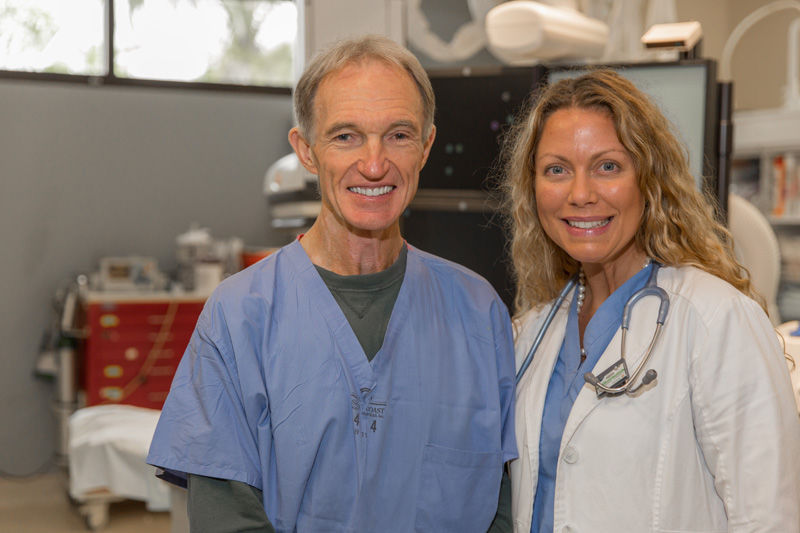Some of the biggest breakthroughs in medicine come in the smallest packages.
Take, for example, the stent.
Looking very much like a miniaturized version of a spring from a click-top ballpoint pen, stents have been in use to treat blocked arteries, or arteriosclerosis, since 1986. But according to interventional cardiologist Dr. Charles Croft at the Sebastian River Medical Center, a new and potentially game-changing stent technology is now available.
These new “bio-absorbable polymer drug-eluting” stents were approved by the FDA this year.
According to the American Heart Association, when a coronary artery – an artery feeding the heart muscle – is narrowed by a buildup of fatty deposits called plaque, it reduces blood flow. If blood flow is reduced to the heart muscle, chest pain can result, and if a clot forms and completely blocks the blood flow to part of the heart muscle, a heart attack results.”
Stents – tiny wire mesh tubes that are inserted into arteries and left there permanently – help keep arteries open and dramatically reduce the risk of a heart attack.
But stents can also lead to life-threatening problems.
According to the affable Croft, with earlier generations of stents there were two main things that could cause problems. “One,” he says, “is they could clot up, and two is they could re-narrow,” just like an artery does before a stent is installed.
Those problems, also known as “in-stent thrombosis” and “restenosis,” have plagued doctors and patients for years.
WebMD says in-stent thrombosis (blood clots forming inside that mesh tube), along with the development of restenosis (scar tissue forming inside the artery causing it to re-narrow), have sometimes forced doctors to re-perform the stenting procedure after only a few months and, in worse-case scenarios, to resort to full-blown coronary bypasses.
Enter the bio-absorbable polymer drug-eluting stent.
Made of platinum chromium, these stents are laser-cut and covered with a smooth, biodegradable polymer coating containing the drug everolimus which “elutes” or dissolves into the artery and the bloodstream over a 90-day period to help prevent the scarring of restenosis, while also reducing the need for patients to adhere to lengthy or even lifelong post-op blood-thinner and aspirin therapies to reduce the risk of in-stent thrombosis.
Moreover, Croft says they are also “more deliverable.”
The National Heart, Lung and Blood Institute’s version of that “delivery” or implant procedure is this: To open a narrowed artery and place a stent inside it, doctors use a procedure called a “percutaneous coronary intervention” or angioplasty. A balloon-tipped catheter is inserted into an artery and moved to the point of blockage. Then the balloon is inflated. This compresses the plaque and opens the narrowed spot. When the balloon is inflated, the stent expands, locks in place and forms a scaffold which holds the artery open. The stent stays in the artery permanently and holds it open.
“It’s not just the [new] stent itself, but the whole shank of the catheter, the whole catheter, the whole length of the shaft that has the stent on it, is designed with laser cutting on it to make it more flexible while also maintaining its strength.”
Croft says these new stents are racking up some impressive statistical successes.
In two separate clinical trials, they had a remarkably low 1.1 percent rate of restenosis after one year, as opposed to a 20-to-30 percent rate for older stents not coated with a drug.
Even more impressively, the Synergy stents used at SRMC, which are made by Boston Scientific, garnered a perfect zero percent rate of in-stent thrombosis in clinical trials after four years.
Croft calls the zero percent clotting rate at four years “impressive.”
Jennifer Konowitz of the SRMC catheterization laboratory is even more enthusiastic, and quickly adds that “this hospital is really at the cutting edge. This stent is not even available at some of the big regional hospitals nearby.”
Croft performed the first implant of these new stents on July 25 this year and says, “We’ve done an awful lot of cases [since] and haven’t had a single patient come in with a thrombosis or clotting of the stent.”
In no small part because of advances such as this, the consulting firm GlobalData projects that the market for stents will grow to the $5.6 billion level over the next four years.
Dr. Charles Croft is with both the Sebastian River Medical Center and the Holmes Regional Medical Center in Melbourne. The phone number is 321-722-3288.

